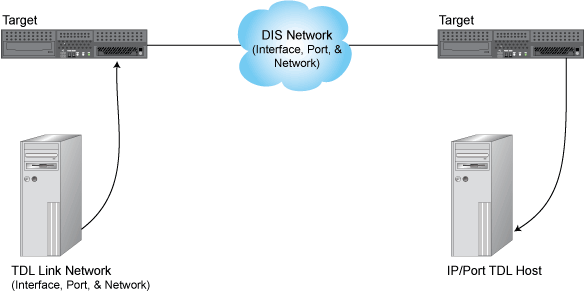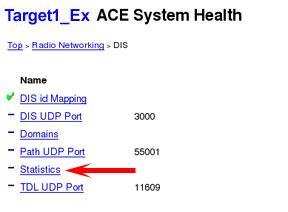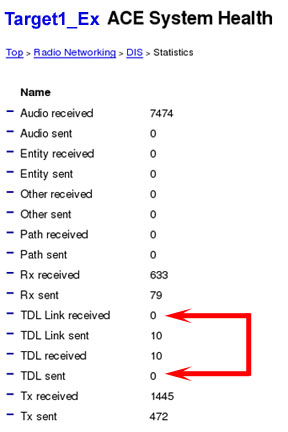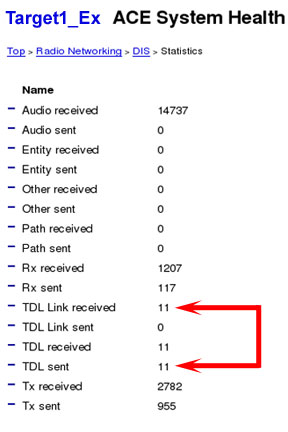Application Note
Using ASTi's Tactical Data Link/Data Bridge Feature (#26.7)
Part VII (Telestra 4)
Using TDL with Telestra
Tactical Data Link (TDL) in Telestra is similar to the DACS interface with some noticeable differences. The basic concept is the same in that the packet data structure is sent via signal PDUs (see Part II of this Application Note), radios are used to transmit the data, and the DIS network is used as a conduit. The differences in Telestra include:
- All TDL configuration is set in Studio.
- All radios are TDL capable.
- The radio handles voice-data contention. If a radio is actively transmitting voice, a data message from the host will be buffered until voice transmission has completed.
- Rather than simply bridge the data, it is transported through the radio component and data throttling may be applied.
- Radios utilize the message size and data rate fields in the signal PDU header. A radio will hold in active transmit for the appropriate amount of time.
- A radio will transmit data messages as soon as it is sent from the host, a 'Data Signal Tx' flag from the host computer is not needed to transmit the data onto the DIS or HLA network.
Network Types and Data Flow
TDL requires two main networks:
- DIS Network – Network which contains Transmitter and Signal PDUs for audio and Tactical Data Link radio communications.
- TDL Link Network – Host Network where the Host platform sends TDL formatted packets to the Telestra server for distribution on to the DIS network. From the DIS network, the TDL messages are received (by the radios) and are then sent to the host on this network. This is a TDL message that is used to exchange data locally between a simulated radio and the local host that represents the local TDL modem for that radio. It is transported over a dedicated IP port (and possibly interface as well) in the form of DIS TDL PDUs.

- The host sends a TDL PDU on its TDL Link interface to the Telestra server. This represents the data that the host wants to broadcast from a particular simulated radio.
- The Telestra server receives the PDU from the host platform and queues it up for transmission by the selected radio.
- The radio will then transition from on to ActiveTx and send the data onto the DIS network. The radio will maintain its ActiveTx state for a period of time determined by the size of the data divided by the transmission rate.
Note that the PDU containing all of the data is sent immediately after the radio transitions to the ActiveTx state.
- The in-tune and in-range radio receivers will receive the data from the DIS Network and queue it up for access to the appropriate host.
- Once received and de-queued the radio receiver will send the TDL Packet onto the TDL Link port where it is then sent to the host.
Configuring the Data Bridge in Studio
The Telestra server will only receive and transmit DIS TDL Link PDUs over a dedicated network interface.
There are three required entries within the interface section of the DIS server configuration file:
- tdl_if - specifies the name of the interface that is used for both send and receive. Typically, this is Eth0.
- tdl_port - specifies the UDP port number to use for both send and receive.
- tdl_ucast - specifies the IP address to use when sending TDL Link PDUs to the host.
Example:
[interfaces]
main_mcast = 234.123.012.001
port = 53000
if = eth0
tdl_ucast = 12.23.56.78
tdl_port = 53123
tdl_if = eth0
TDL Statistics in the Health System
The Health System that is part of the Telestra server allows a user to monitor various systems and sub-systems running on the platform through the Telestra web interface. In the Telestra web interface, select the following:
System > Health
Show Detail
Radio Networking > DIS > Statistics
Statistics related to TDL messaging are seen as follows:
- TDL Link received - TDL packets received from the host computer
- TDL Link sent - TDL packets sent to the host computer
- TDL received - DIS TDL packets received on the DIS network, typically from another Telestra server.
- TDL sent - DIS TDL packets sent onto the DIS network, typically to another Telestra server.
When the host sends a TDL packet to the Telestra server and it is transmitted over the DIS network the following counters will increment:
- TDL Link Received (from host)
- TDL Received
- TDL Sent (transmitted over network)
When a radio receives a TDL message and sends it to the host the following counters increment:
- TDL Received (from DIS network)
- TDL Link Sent (back to the host)
Debugging Common TDL Problems in Telestra
Symptom: The TDL Link received counter is incrementing but TDL sent counter is not incrementing.
This can happen for a number of reasons:
- The Site, App, Entity, and Radio ID inside of the TDL packet does not match a radio in the Telestra model.
- The radio inside the model cannot transmit data in it's current state, e.g. the radio is tuned off and does not have power.
- The Data Length field of the TDL packet is not accurate and the packet is dropped instead of being sent.





